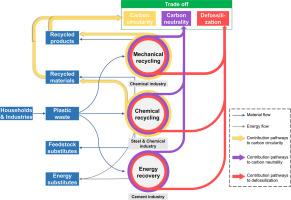Quantifying the carbon circularity, climate and energy benefits of plastic recycling through circular flow analysis: Application to plastic packaging waste in Japan
IF 10.9
1区 环境科学与生态学
Q1 ENGINEERING, ENVIRONMENTAL
引用次数: 0
Abstract
Carbon circularity has attracted increasing attention alongside climate change impacts and fossil energy consumption in plastic recycling evaluations. Herein, we introduce the carbon flow and circular diagram (CFCD) method, a unified framework designed to assess plastic recycling by integrating carbon circularity, carbon neutrality, and fossil energy independence. CFCD visualizes carbon flows by mapping carbon inputs and outputs across various pathways. We apply our approach to the complex ecosystem of plastic packaging waste recycling in Japan. Our findings reveal that catalytic cracking preserves 56.8 % of carbon circularity, whereas mechanical recycling achieves moderate carbon circularity and climate benefit. High-efficient energy recovery delivers substantial climate and energy benefits with poor circularity. Gasification for ammonia production yields the highest energy benefit of 57.9 MJ/kg of waste yet is largely ineffective in improving carbon circularity, whereas the carbon capture and utilization emerges as a key strategy.

通过循环流分析量化塑料回收的碳循环度、气候和能源效益:在日本塑料包装废弃物中的应用
在塑料回收评估中,碳循环性与气候变化影响和化石能源消耗一起越来越受到关注。在此,我们介绍了碳流和循环图(CFCD)方法,这是一个统一的框架,旨在通过整合碳循环性、碳中和性和化石能源独立性来评估塑料回收。CFCD通过绘制不同途径的碳输入和输出图来可视化碳流。我们将我们的方法应用于日本塑料包装废物回收的复杂生态系统。我们的研究结果表明,催化裂化保留了56.8%的碳循环,而机械回收实现了中等碳循环和气候效益。高效的能源回收提供了大量的气候和能源效益,但循环性差。气化制氨的能源效益最高,为57.9兆焦耳/千克废物,但在改善碳循环方面基本上无效,而碳捕获和利用成为关键战略。
本文章由计算机程序翻译,如有差异,请以英文原文为准。
求助全文
约1分钟内获得全文
求助全文
来源期刊

Resources Conservation and Recycling
环境科学-工程:环境
CiteScore
22.90
自引率
6.10%
发文量
625
审稿时长
23 days
期刊介绍:
The journal Resources, Conservation & Recycling welcomes contributions from research, which consider sustainable management and conservation of resources. The journal prioritizes understanding the transformation processes crucial for transitioning toward more sustainable production and consumption systems. It highlights technological, economic, institutional, and policy aspects related to specific resource management practices such as conservation, recycling, and resource substitution, as well as broader strategies like improving resource productivity and restructuring production and consumption patterns.
Contributions may address regional, national, or international scales and can range from individual resources or technologies to entire sectors or systems. Authors are encouraged to explore scientific and methodological issues alongside practical, environmental, and economic implications. However, manuscripts focusing solely on laboratory experiments without discussing their broader implications will not be considered for publication in the journal.
 求助内容:
求助内容: 应助结果提醒方式:
应助结果提醒方式:


